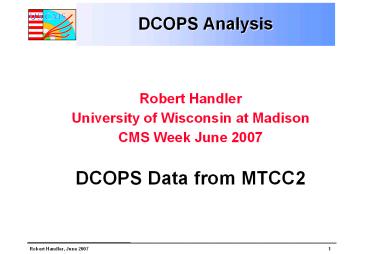DCOPS Analysis - PowerPoint PPT Presentation
1 / 11
Title:
DCOPS Analysis
Description:
Consistency check: CCD4. Peak position (pixels)before laser tip correction. After ... on B. Highest field data is most stable but taken over a short time ... – PowerPoint PPT presentation
Number of Views:33
Avg rating:3.0/5.0
Title: DCOPS Analysis
1
DCOPS Analysis
- Robert Handler
- University of Wisconsin at Madison
- CMS Week June 2007
- DCOPS Data from MTCC2
2
Outline
- Quadratic fits to deflection in z versus field
strength. - Laser control failures in MTCC data
- Evidence for laser angle instability.
- Field strength dependence of instability.
3
Two lasers stuck on
Fit peaks for gaussian. Red points mean both
lasers on (!) so hand-select peaks.
Laser 21/PT 2
Quadratic fit to hand-selected points
Laser 22/PT 5
Field in tesla
4
A case of wrong laser on
ME3/SLM3
Appears laser 25 laser 30 was flakey, sometimes
stuck on, while laser 25 was stuck off.
Laser 25/PT 3
Laser 30/PT 6
Field in tesla
5
Data selection
- Pick by eye points for use in a quadratic fit as
a function of magnetic field. - Points near (125 pixels) fit are considered
good for further analysis
6
Evidence for laser tip (CCD2)
Peak position (pixels)before laser tip correction
gtgt time in days
Correct each SLM read for a average laser angle
tip much more reproducible! Angle shifts happen
within a day. (Our min time between reads1 hr)
After
7
Consistency check CCD4
Peak position (pixels)before laser tip correction
gtgt time in days
The angle shifts account for jumping in both ccd
2 and ccd 4.
After
8
Angle instability vs Field
RMS peak jitter for fixed field w/o (black) and
with (red) correction for laser angle. Bottom
axis of each small plot is DCOPS position along
the line
Conclusion No systematic dependence on B.
Highest field data is most stable but taken over
a short time period.
ME2
0.0 T
3.0 T
3.5 T
3.8 T
4.0 T
9
Angle variation
The laser tip angle distribution has an RMS of
.012 mrad
10
Hand fit z(B) for 5 SLMS
3.0 T 3.5 T 3.8 T 4.0 T
Deviation (pixels) of peak from zero field value,
corrected for laser tip and overlapped lasers
merged.
gtDistance along SLM (mm)
Deviation (pixels)of peak in (CCD4 and CCD2) from
merged laser lines for all lines and B-fields
Differences (pixels)between CCD4 and
CCD2 (x2(B)-x2(0))-x4(B)-x4(0)).
11
Conclusions
- The laser angles exhibit some instability.
Probably this does not effect the ultimate
alignment results unless a jump occurs during a
laser shot. - Agreement between CCD2 and CCD4 on deflection vs
field is about 10 pixels (FWHM).































